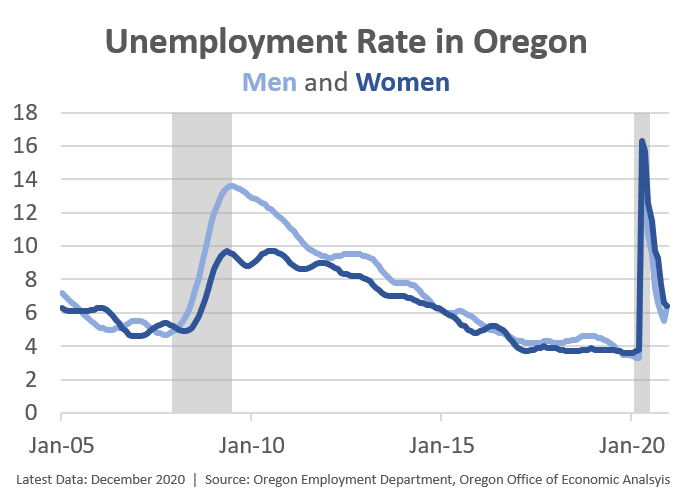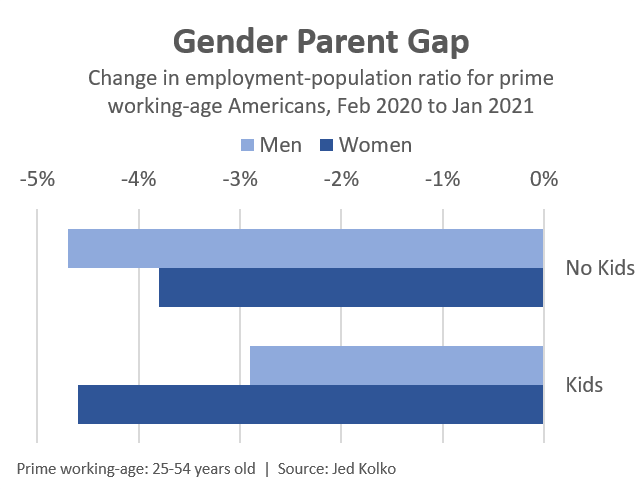
By Josh Lehner
Oregon office of Economic Analysis,
Women suffered disproportionate layoffs and higher unemployment rates at the start of the pandemic. However since last spring, much of the gender gap in employment has effectively closed. As of January 2021, male employment in the U.S. was down 5 percent, while female employment was down 6 percent. Here in Oregon the female and male unemployment rates in December 2020 were the same. Noisy monthly data can be challenging and has resulted in some stronger headlines about these gender differences than is probably warranted from the big picture perspective.
That said, while these topline numbers do not show large gender disparities, the same cannot be said if we focus just on parents.
Overall we know that many families are in a bind with online learning. Nearly 1 in 5 Oregonians in the workforce meet the following definition: they have children, work in a job that cannot be done from home, and do not have another non-working adult present in the household. These Oregon parents likely face the direct trade off of going to work, or staying home to take care of the kids, or trying to arrange childcare which is restricted by the pandemic and hard to find and afford to begin with.
Another 11 percent of Oregon’s workforce has kids, do not have another non-working adult present, but can work from home. Juggling work responsibilities and ensuring their kids attend class and get their homework done is a daily struggle, to say the least.
In America we know taking care of the family and household more broadly disproportionately falls on moms. Nationally moms have seen much larger employment losses than dads have. In fact nearly 1 million moms have left the labor force in the past year, twice that of dads. In Oregon that’s the equivalent of around 12,000 mothers leaving the labor force.
Besides the lack of in-person schooling, another contributing factor to the gender parent gap is likely the gender wage gap. If a household has to choose an adult to stay home, it makes more financial sense for the lower-earning worker to do so, which usually means the mom.
Looking forward our office has built in two impacts in the economic outlook from a return of in-person schooling.
First there are the direct jobs associated with in-person schooling. Education employment is down considerably since the start of the pandemic. A portion of these losses are office staff, lunch workers and bus drivers, however the vast majority of the losses are teachers themselves. This is primarily due to the lack of substitute teachers being used with online learning, not layoffs to full-time teaching positions. Given around 75 percent of elementary and middle school teachers are women, and high school teachers are evenly split between men and women, the direct jobs boost from in-person learning will disproportionately impact women.
Second there is the indirect impact of freeing parents’ ability to work when the kids return to the classroom. Parents – primarily moms – will be able to work again if they want, increase their hours, or at a minimum be more productive as they will no longer be simultaneously trying to manage online school and do their jobs.
As the pandemic wanes, our office expects a stronger economic recovery than has been experienced in recent cycles. As a result, Oregon parents are likely to return to the workforce in greater numbers this year as the kids return to classrooms and businesses are looking to hire to keep up with demand. That said, it is always important to continue to monitor these big changes seen during recessions. Research indicates that the longer a spell of unemployment lasts, the lower the probability of finding a job and the higher the probability of dropping out of the labor force entirely. Once someone leaves the labor force, it is harder to return. A drop in the labor force overall, should it persist, represents a reduction in the productive capacity of the economy.
In the years leading up the pandemic, Oregonian moms had begun to return to the labor force in greater numbers due to the strong economy. In fact the share of Oregon moms in the labor force hadn’t been higher in decades. While not the baseline outlook, it is possible the pandemic will undo much of these gains. In the event this does happen, it would likely take years to regain the losses.
Bottom Line: The return to in-person schooling is expected to provide a double boost to the labor market. The increase in teaching positions, and freeing up parents’ time will disproportionately impact moms who have lost, or given up their jobs and stayed home in greater numbers during the pandemic.
Note 1: All of this leaves to the side any discussion in terms of the impact of distance learning on educational attainment, and disparities in terms of access to technology where lower-income, BIPOC, and rural households are less likely to have high-speed internet at home.
Note 2: During our office’s testimony in front of the House Committee on Early Childhood, a question was raised about the impact of daycare providers who close permanently. There is always the risk of supply side disruptions. It usually takes time for new businesses to replace lost ones during an economic recovery. To the extent this does happen today, it could slow the recovery or at least leave more parents in a bind until daycare slots open.
Note 3: The current discussion in Washington D.C. about expanding the Child Tax Credit would have a large financial benefit for families and result in a significant reduction in child poverty.
Disclaimer: Articles featured on Oregon Report are the creation, responsibility and opinion of the authoring individual or organization which is featured at the top of every article.




